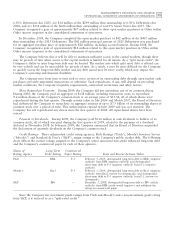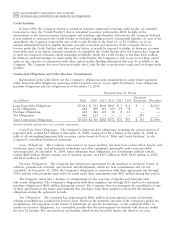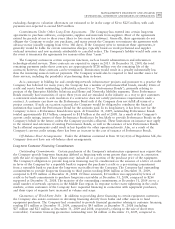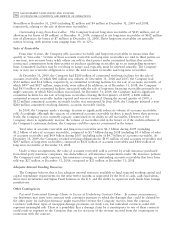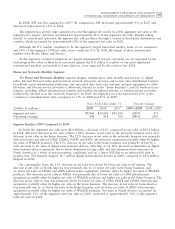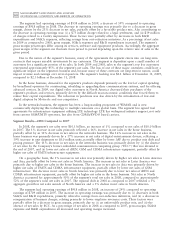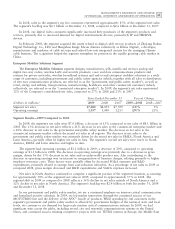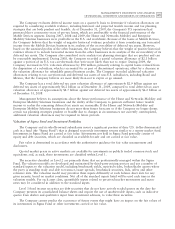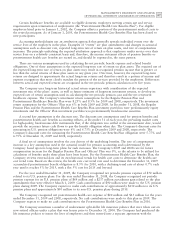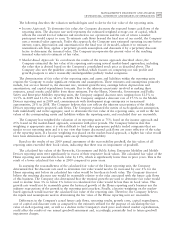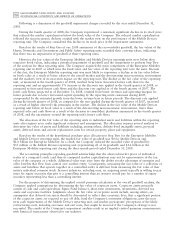Motorola 2009 Annual Report Download - page 70
Download and view the complete annual report
Please find page 70 of the 2009 Motorola annual report below. You can navigate through the pages in the report by either clicking on the pages listed below, or by using the keyword search tool below to find specific information within the annual report.
62 MANAGEMENT’S DISCUSSION AND ANALYSIS
OF FINANCIAL CONDITION AND RESULTS OF OPERATIONS
and Asia. These larger systems are more complex and include a wide range of capabilities that our technological
innovations are able to provide.
Customers served within the commercial enterprise market continue to face challenging, yet stabilizing,
economic trends. As these customers choose to purchase, upgrade and replace equipment in the future, they can
choose from a variety of our product offerings. During the year, we announced the new MC9500, an industrial-
class rugged mobile computer, our first of its kind ‘‘rack and rail’’ accessory for cost-effective and efficient back
office management, as well as the MT2000 series of handheld barcode scanners that incorporates the benefits of a
mobile computer.
Customer budget constraints within all of the industries we serve have resulted in lower spending for the full
year 2009 compared to 2008. However, we have recently been experiencing stable levels of demand and we
believe that our comprehensive portfolio of products and services and market leadership make our Enterprise
Mobility Solutions business well-positioned for growth as the worldwide economy begins to improve.
Segment Results—2008 Compared to 2007
In 2008, the segment’s net sales were $8.1 billion, an increase of 5% compared to net sales of $7.7 billion in
2007. The 5% increase in net sales reflects an 8% increase in net sales to the government and public safety
market, partially offset by a 2% decrease in net sales to the commercial enterprise market. The increase in net
sales to the government and public safety market was primarily driven by: (i) increased net sales outside of North
America, and (ii) the net sales generated by Vertex Standard Co., Ltd., a business the Company acquired a
controlling interest of in January 2008, partially offset by lower net sales in North America. On a geographic
basis, the segment’s net sales were higher in EMEA, Asia and Latin America and lower in North America.
The segment had operating earnings of $1.5 billion in 2008, an increase of 23% compared to operating
earnings of $1.2 billion in 2007. The increase in operating earnings was primarily due to an increase in gross
margin, driven by: (i) the 5% increase in net sales, (ii) a favorable product mix, (iii) the absence in 2008 of an
inventory-related charge in connection with the acquisition of Symbol Technologies, Inc. (‘‘Symbol’’) during the
first quarter of 2007, and (iv) a decrease in SG&A expenses, primarily related to savings from cost-reduction
initiatives. The increase in gross margin was partially offset by increased R&D expenditures, primarily due to
developmental engineering expenditures for new product development and investment in next-generation
technologies. As a percentage of net sales in 2008 as compared to 2007, gross margin, R&D expenditures and
operating margin increased, and SG&A expenses decreased.
Net sales in North America continued to comprise a significant portion of the segment’s business, accounting
for approximately 57% of the segment’s net sales in 2008, compared to approximately 62% in 2007. The
regional shift in 2008 as compared to 2007 reflects 19% growth in net sales outside of North America and a 4%
decline in net sales in North America. The segment’s backlog was $2.4 billion at December 31, 2008, compared
to $2.3 billion at December 31, 2007.
During 2008, the segment also: (i) acquired a controlling interest in Vertex Standard Co., Ltd., a global
provider of two-way radio communication solutions, and (ii) completed the acquisition of AirDefense Inc., a
leading wireless local area network (WLAN) security provider.
Significant Accounting Policies
Management’s Discussion and Analysis of Financial Condition and Results of Operations discusses the
Company’s consolidated financial statements, which have been prepared in accordance with U.S. generally
accepted accounting principles. The preparation of these financial statements requires management to make
estimates and assumptions that affect the reported amounts of assets and liabilities and the disclosure of
contingent assets and liabilities at the date of the financial statements, as well as the reported amounts of
revenues and expenses during the reporting period.
Management bases its estimates and judgments on historical experience, current economic and industry
conditions and on various other factors that are believed to be reasonable under the circumstances. This forms
the basis for making judgments about the carrying values of assets and liabilities that are not readily apparent
from other sources. Actual results may differ from these estimates under different assumptions or conditions.
Management believes the following significant accounting policies require significant judgment and estimates:
—Revenue recognition



